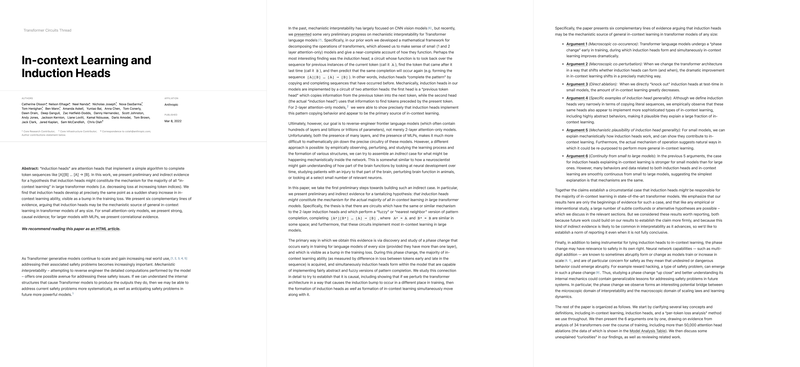In-Context Learning and Induction Heads: A Summary
The paper "In-context Learning and Induction Heads" by Olsson et al. from Anthropic investigates the mechanisms behind in-context learning in large transformer models, focusing specifically on the role of "induction heads" within attention heads. This specialized paper is driven by the overarching goal of understanding the internal computations of transformer models, which has profound implications for model interpretability and safety in AI.
Key Hypothesis and Evidence
The hypothesis central to this paper is that induction heads significantly contribute to in-context learning across transformer models of varying sizes. An induction head is defined precisely as an attention head that attends to the prior instance of a token and predicts the subsequent token based on past occurrences.
The authors present six main arguments to support this hypothesis, each backed by empirical evidence gathered from multiple transformer models trained on diverse datasets:
- Macroscopic Co-occurrence:
- There is an observable phase change early in transformer training where induction heads form concurrently with a sharp increase in in-context learning.
- This change is visible as an abrupt improvement in the model’s loss curve and remains stable after this point.
- Macroscopic Co-perturbation:
- Altering the transformer’s architecture to either facilitate or delay the formation of induction heads results in corresponding shifts in the onset of in-context learning improvements.
- This was demonstrated using a "smeared key" architecture, which allowed the formation of induction heads in one-layer models, proving that multiple layers are not strictly necessary when facilitated by specific architecture changes.
- Direct Ablation:
- Ablation experiments on small attention-only models show that directly removing induction heads leads to a significant reduction in in-context learning capability.
- These findings are compelling for small models but are less conclusive for larger models with MLP layers due to the complexity of interactions between various components.
- Specific Examples of Induction Head Generality:
- Induction heads, while defined narrowly in terms of simple pattern completion tasks, also demonstrate capabilities in more abstract forms of in-context learning, such as translation and complex pattern matching.
- Mechanistic Plausibility of Induction Head Generality:
- The mechanistic decoding of induction heads in small models shows how they functionally contribute to in-context learning.
- The mechanism by which they perform simple sequence copying can be generalized to more abstract forms of pattern completion.
- Continuity from Small to Large Models:
- The qualitative and quantitative behaviors of induction heads are consistent from small to large models.
- This suggests that the mechanisms observed in small models likely scale to larger, more complex models.
Implications for AI Safety and Future Research
The findings of this paper have several implications for both practical applications and theoretical understanding of AI systems.
- Safety Considerations:
- Understanding induction heads can help mitigate risks associated with in-context learning, where model behavior can change based on input sequences, potentially leading to unanticipated and undesired actions.
- This understanding can also contribute to addressing safety issues related to phase changes, where abrupt changes in model capabilities can pose significant risks.
- Interpretability and Predictability:
- Mechanistic insights into transformer models enable more systematic approaches to addressing safety concerns and enhance the predictability of model behavior.
- Anticipating how models will form and use induction heads during training can lead to improved methods for monitoring and guiding model development.
- Theoretical Developments:
- The connection between phase changes in in-context learning and induction heads may serve as a bridge linking various fields such as scaling laws, learning dynamics, and mechanistic interpretability.
- Future research can build upon these findings to explore more complex models and corroborate the role of induction heads across different architectures and tasks.
Conclusion
Overall, the paper provides comprehensive and robust evidence for the crucial role of induction heads in in-context learning within transformer models. The research highlights the importance of detailed mechanistic understanding in AI development, emphasizing the balance between empirical observation and theoretical modeling to enhance both interpretability and safety. Moreover, the findings pave the way for future explorations into more sophisticated models, reinforcing the notion that insights gleaned from small models can significantly inform our understanding of larger, more complex systems.
